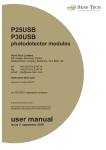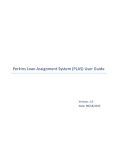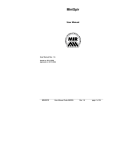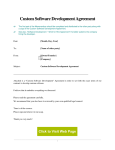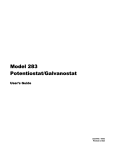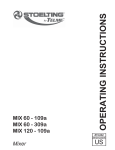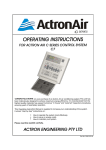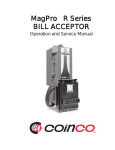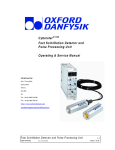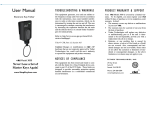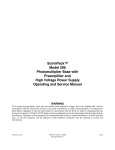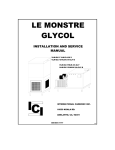Download CT2 Counter Module User Manual
Transcript
CT2 Counter Module User Manual Detector Modules Group Electron Tubes Limited Bury Street Ruislip HA4 7TA UK. December 2002 CONTENTS 1. PRECAUTIONS 2. INSTALLATION 3. START-UP SOFTWARE 4. PROGRAMMING 5. TROUBLESHOOTING 6. BACKGROUND INFORMATION APPENDIX A - Interface Characteristics APPENDIX B - Environmental Conditions APPENDIX C - Outline Drawing APPENDIX D – Active X Component 1 1. PRECAUTIONS SUPPLY VOLTAGE Ensure the +5V supply voltage does not exceed +5.25V. Exceeding +6.0V on the Module may result in permanent damage to the unit and it will have to be returned to the factory for repair. (See Appendix A.) MAINTENANCE There are no user maintainable components in the Module. Modules should be returned to Electron Tubes for repair. ENVIRONMENT The Module should not be exposed to levels outside those specified in Appendix B. 2 2. INSTALLATION The following instructions will enable users to utilise the software provided, to operate the CT2 Module, such that results can be taken immediately and the hardware setup can be checked. 1. System Requirements PC operating under Microsoft Windows® 98, 2000 or XP Mouse or tablet VGA resolution monitor or higher CD ROM drive +5V Power Supply 2. Interfaces (See Appendix A for details) Connect Detector signal to input BNC on CT2. Connect the 9 way connector to the serial port on the computer, noting which port is used. Connect a +5V Power Supply to the Power Connector on the Module. If used, make the appropriate connections to the User out 1 (pin 1) & 2 (pin 6) and the Trig in (pin 2). Switch on the computer and +5V Power Supply. 3. Software Installation Insert the “EM6 Counter/Timer Software" compact disc into the CD-ROM drive of your computer. Note: CT2 installation set-up starts automatically on most computers. If it doesn’t on your computer, click the START button, and then click RUN. In the RUN dialog box, type d:\setup, where d: is the letter of your CD-ROM drive. 4. Software Operation On entering the program a product request screen shall be displayed. CT2 needs to be selected here. 3 Before starting counting the correct communications port must be selected. Dependant on which communications port the Module has been plugged into on the computer, go into File and then New and select the appropriate port. This will then be saved as the default setting. If an incorrect port is selected an error box will be displayed and the user should select another port. The Module is now ready to be used. By selecting Window & Show Control Window the control window will be displayed and allow the counter to be started, based on the settings in this window. Detailed setting up instructions can be found in Section 3, Start up Software. 4 3. START-UP SOFTWARE Software has been provided with Module to allow for immediate use of the product without the need for writing new software programmes. However, custom user programmes may be required and Section 4. PROGRAMMING defines the necessary interface protocol for users to follow. The software provided, with the Module, can be operated by carrying out the following simple steps. Before using the software the Module must be connected as stated in Section 2. INSTALLATION. If the Control box is not already displayed, select it from the Tool bar in the Window box. Control Window In the Control Window set up the following: 1. Readings Select the total number of readings you wish to take ( 32000 max ). 2. Period Select the period of the reading ( 10ms to 300s ). By clicking on the box that states the units of the period setting, the user can toggle between ms (10 – 2500) & s (1 – 300). When s (1 – 300) is used the software reads counts from the hardware every 1s and then accumulates the results until the desired period is achieved. When ms (10 – 2500) is used the software reads counts from the hardware dependent on the period set. 3. Trigger Mode Select the trigger mode as either Off, Fixed or Continuous 4. User outputs. Select the Output Signal as on or off. This will then control the appropriate external output line, switching it between logic “1" and “0" to permit control of external apparatus, such as a shutter mechanism. (See Appendix A) 5 5. Start / Stop Selecting Start / Stop will either Start or Stop the software. On selecting Start the software shall function depending on the selection made in the Control Window. EM6 Counter / Timer software window 6 EM6 Counter / Timer Software Window The following facilities are available from the Main Window, both as drop down menus and as items on the toolbar. File New Enables the communication lines to be set as stated in Section 2. Installation. Open Open enables the user to select a previous set of results for analysis. Save Save enables the user to save a set of results. Save as Enables the user to change the save file name. Print Graph Only Data Only Graph & Data Print Graph Only prints out the graph of results. Print Data Only prints out the table of results. Prints out both the data and graph of results. Note : By clicking on the graph on the screen, titles can be set for the graph to appear on the printed copy. Exit Exit exits the program. Change product This enables the hardware type to be changed. Edit Linearity Correction This enables the count rate correction value to be inserted to ensure linearity is maintained for the full dynamic range of the photon counting product being used. See Section 6. BACKGROUND INFORMATION for more information. Copy Copies highlighted data to the clipboard to enable it to be pasted into other software applications, such as a spreadsheet or word processor. Select All Selects and highlights all of the data in the table. Technical support This takes you to the Electron Tubes web site, where a list of technical support contacts are available. About This states the software version being used. Help 7 4. PROGRAMMING The following table lists the commands necessary to operate the Module, when an independent software application is to be written. In addition an ActiveX control driver is provided on the installation CD, together with example programmes for use with Excel, Lab View, Visual Basic and Delphi. Details of this module are shown in Appendix D. Command Description I. The readings can only be initiated, and settings can only be set, by sending commands from the PC. The results from a Start command are sent to the PC as four binary bytes. Commands are acknowledged by sending a two-character ASCII message to the PC. All commands from the PC consist of ASCII characters and must be terminated with a Carriage-Return - Line-Feed pair (CR/LF), except for the Stop command which is just a CR. All Command acknowledgments and all results sent to the PC are not terminated with a CR/LF pair. II. All commands will stop any reading in progress, or stop any EEPROM memory transmission to the PC, and then perform the specified action. III. Generally, a command will cause a transmission of a message or transmission of readings to the PC as indicated below. IV. The commands are case sensitive. V. Also initial characters other than S, C, L, E, M, B, R, P, T, O, D and V will be ignored. If the character following a correct initial character is incorrect, or a character pair other than a CR/LF is received when a CR/LF character pair is expected, a BC (Bad Command) message is sent to the PC. VI. A ST (Start Message) is sent to the PC at power-up and whenever a Reset occurs. 8 Command S Action Starts R readings where each reading is timed over P*10ms. C Starts continuous readings where each reading is timed over P*10ms. The readings are terminated by sending the Stop command (CR) or other command Allows continuous readings. Readings are initiated, where each reading is timed over P*10ms, whenever the External Trigger pin is 1; and inhibits readings whenever the External Trigger pin is 0. Sending the Stop command (CR) or other command terminates this mode of operation. Allows R readings, where each reading is timed over P*10ms. Each reading is initiated at the positive edge of the External Trigger pin. This may be repeated any number of times. Sending the Stop command (CR) or other command terminates this mode of operation. Starts R readings where each reading is timed over P*10ms. The readings are sequentially stored in the non-volatile EEPROM along with the number of readings taken, overwriting the currently stored readings. Overflowed readings are also stored. If R is greater than 126, only 126 readings are taken and stored. Sends the readings held in the non-volatile memory to the PC. These readings remain in the non-volatile memory until overwritten by the consequences of an M command. Cancels the current set of readings. If in the Continuous External Trigger mode, it is cancelled. Sets the Number of Readings setting (R) to the byte value of the character following R. A 0 is seen as 1. Numbers greater than 255 cause a BC message to be sent to the PC. The default Number of Readings is 1. Sets the Periods setting (P) to the number following P. A 0 is changed to 1. Numbers greater than 255 cause a BC message to be sent to the PC. The default Periods is 10. L E M B CR R followed by a character. P followed by a character. 9 Returns to PC At the end of each reading, the reading is sent to the PC in binary form as 4 bytes with the most significant byte sent first. If the count becomes greater than 67,108,863 during a reading, that reading is terminated immediately and an error reading is sent to the PC. The software then continues with the next reading. An error reading is distinguished by having the most significant bit of the first byte as a 1, otherwise it’s a 0. Thus a valid reading has a maximum of 31 bits. The VA (Valid) message first. Then, when initiated as described, the readings are sent to the PC as for the S and C commands above. No readings are sent to the PC, but when all of the readings have been taken the MF message is sent to the PC. The readings held in the nonvolatile memory. The SP (Stopped) message. The VA (Valid) message. The VA (Valid) message. Command T followed by a number, 0 to 500 (ie. 1 to 3 digits) O followed by a character. V followed by two characters D Action Sets the Linearity setting (T) to the number following T. A 0 turns off the linearity transformation. Numbers greater than 500 cause a BC message to be sent to the PC. On power up the previous Linearity setting is reinstated. The initial Linearity setting is factory set during manufacture. Turns on the Output Signal 1 when the character following the O has a byte value of 1, or turns the Output Signal 1 off the when it has a byte value of 0. Byte values greater than 1 cause a BC message to be sent to the PC. The default value is off. Turns off the Output Signal 2 when both of the characters following the V have byte values of zero, or turns on the Output Signal 2 if either one of the characters has a byte value that is not zero. The default value is off. Turns on the Output Signal 2. 10 Returns to PC The VA (Valid) message. The VA (Valid) message. The VA (Valid) message. The VA (Valid) message. 5. TROUBLE SHOOTING 1. No Counts Check all connections have been made correctly. Check the +5V Power Supply is on and correctly set. Check the Detector is funtioning properly. 2. Count Overflow or Very High Count Rates Check Detector optical connection is light tight. 3. Software will not Install Check computer running Windows 98, 2000 or XP. 4. No Readings can be taken Check count mode not selected to external trigger or trigger not available. 11 6. BACKGROUND INFORMATION 1. Operating Principles: Many photodetector packages use photomultiplier tubes operating in the photon counting mode. The following paragraphs summarize the salient features of this technique and provide typical performance data for these packages. 1.1. Photon Counting: The following section details the background information for Photon Counting, the primary role for the CT2 Module. Photon counting is the most sensitive method for measuring weak or short lived light emissions. Each photon incident on the photocathode has a wavelength dependent probability of releasing a photoelectron. This probability is known as the quantum efficiency (QE) and is normally expressed as a percentage. Typical spectral response characteristics for the photocathodes used in photon counting detectors, including optical transmission and reflection losses in the photomultiplier window, are shown in Figure 1. Photoelectrons emitted by the photocathode are accelerated and focused by electric fields onto the first dynode of the electron multiplier section of the photomultiplier. On impact, each photoelectron liberates a number of secondary electrons which are, in turn, accelerated and focused onto the second dynode. The process is repeated at each subsequent dynode and the secondary electrons from the tenth and last dynode are collected at the anode. Resultant charge pulses from the photomultiplier will vary in magnitude due to the statistical nature of the gain process but, so long as they exceed the preset threshold of the discriminator, each will be counted as one pulse. Only ‘small’ pulses, resulting from single electrons originating from intermediate dynodes, will fall below the threshold and be rejected. 12 The voltage applied to the photomultiplier tube in the Detector is normally factory preset to provide the optimum gain for photon counting. At this operating point on the signal counts/voltage plateau characteristic the slope is typically 0.2% per volt, or less. 1.2. Signal-to-Noise: The photoelectric effect is a quantum mechanical process subject to fluctuations described by Poisson statistics. A steady light source generating m photoelectons per second for a period of t seconds will produce an average of mt photoelectrons with a standard deviation of (mt)½. Hence signal-to-noise ratio is given by: mt/(mt)½ = (mt)½ In photon counting there is negligible additional noise generated in the gain process or in the amplifier/discriminator hence this expression is also valid for the complete Detector. It should be noted that the signal-to-noise ratio depends on the number of counts, hence for low count rates an increased measurement period will be advantageous. 1.3. Responsivity: The responsivity of the Detector is the output count rate, less dark counts, for a given light power incident on the photomultiplier input window: λ Responsivity = QE ( λ ) . f . h.c where QE(λ) is the quantum efficiency of the photocathode at wavelength λ, h is Planck’s Constant, 6.626 . 10-34 Js, c is the speed of light, 3 . 108 ms-1, and f is the collection efficiency of the first dynode, typically 0.95 for the standard range of photomultipliers used in photon counting. Hence for 400 nm light, a package with a bialkali photocathode photomultiplier with a typical QE of 0.25 has a responsivity of 4.78 . 1017 counts W-1. 1 fW of 400 nm light incident on the photomultiplier input window will therefore produce a mean output count rate of 478 s-1, excluding dark counts. The temperature coefficient of quantum efficiency, and hence of responsivity, is shown in Figure 2. 13 1.4. Background: Background or dark count is the unwanted signal produced by the photomultiplier tube in the absence of light stimulation. Dark counts in Photon Counting Detectors are a function of photocathode type and temperature as shown in Figure 3. Dynamic Range: 14 Typical dynamic range is shown in Figure 4. Over the majority of their useful operating range the responsivity of Photon Counting Detectors is linear and will produce an output count rate which is proportional to input light power. At low count rates the effect of background or dark counts becomes significant. Some improvement can be achieved by cooling, or at least preventing the package from being heated by other apparatus. Dark count subtraction can be used down to the point at which signal becomes less than about 1/10 of background. Beyond this the statistical uncertainty associated with the subtraction process becomes excessive. In background subtraction the signal count rate is deduced as the difference between the measured rates of (s + b) for signal and background and (b) for background alone. It should therefore be noted that the signal-to-noise ratio for the deduced signal rate will be s/(s + 2b)½, and not s/s½. At high count rates dynamic range is limited by electronic dead-time effects caused by pulse pile-up. Pulses that arrive whilst the discriminator is busy are ignored. Correction for dead time is automatically applied in the form: N = n/(1-nτ) where N is the corrected count rate, n is the measured count rate and τ is the count rate correction factor. 15 APPENDIX A CT2 Interface Characteristics Absolute maximum ratings Test conditions Min Typ Supply Voltage Trigger input volts -1.0 User out 1 current User out 2 load current Output sinking current, Vload = 0.01V, amb = 25C User out 2 load supply Max Units 6.0 V +7.0 V 25 mA 60 mA 24 V Max Units 0.9 V DC characteristics (Ta = 25°C Supply = +4.75V to +5.5V) Test conditions TRIGGER INPUT (TTL) Input low volts (max) Min Typ Pin 2 O/P sinking current Input high volts (min) 1.9 Input low current Vin = 0.45V USER OUT 1 (TTL) Pin 1 Output low volts (max) Output sinking 20mA Output high volts (min) Output sourcing 80µA Ouput sourcing 12µA USER OUT 2 (open collector) Pull Down Resistance Pin 6 Output low V -50 µA 0.5 V 2.4 4.5 V V 0.45 16 CT2 Hirose connector Box lid user out 2 (open drain) user out 1 1 trig in 6 2 5 3 4 0V View looking into socket 17 +5V out APPENDIX B - ENVIRONMENTAL CONDITIONS 1. TEMPERATURE +5 to +55°C (operating) 2. VIBRATION SINUSOIDAL (non-operating) 10 to 500 Hz for 10 cycles in each axis, at a peak amplitude of 2g, 1 octave/min. 3. VIBRATION RANDOM (non-operating) 20 Hz at 0.02 g²/Hz to 50 Hz at 0.02 g²/Hz falling to 500 Hz at 0.001g²/Hz 4. HUMIDITY (non-condensing) 30ºC @ 93% 5. PRESSURE (operating) Pressure reductions from 100 kPa (1 bar) to 68 kPa (0.68 bar). 18 APPENDIX C 67 OUTLINE DRAWING 76 Counter Timer CT2 RS232 5V IN TTL IN I/O 45 19 APPENDIX D The EM6 ActiveX control This is the documentation for the EM6 ActiveX control. It describes the function and parameters of the Methods, properties and events in the control. Several examples accompany this documentation to provide a headstart in development. Currently, examples exist for Visual Basic, Labview, Excel and Delphi. The examples are intended as a guide to programming with the EM6 ActiveX control and not as complete solutions. The following sample method describes the correct sequence for using the EM6 ActiveX control with appropriate examples for each step. 1) First, open the COM port: object.Open(1) 2) Then setup the EM6 device: object.Continuous = false object.Triggered = false object.OutputSignal = false object.OutputVoltage = true object.Period = 10 object.ReadingCount = 100 3) Call the Start method and handle the events generated object.Start 4) Finish by closing the COM port object.Close Remarks Often the comport will be opened for the entire duration of the program. Properties BufferInUse (Readonly) Buffersize Continuous Output Signal Output Voltage Period ReadingCount Triggered Gets the number of readings currently in the buffer that are awaiting processing Gets or sets the number of slots available to the software FIFO buffer. Gets or sets the continuous mode of data acquisition. Setting this property to TRUE causes data acquisition to be continuous. Setting this value to false causes data acquisition to stop after the number of readings specified in the ReadingCount property. Gets or sets the state of the output signal. Setting this property to TRUE causes the output signal to be switched on. Gets or sets the state of the output voltage. Setting this property to TRUE causes the output voltage to be switched on. Gets or sets the counter/timer timeout period. Gets or sets the number of readings to be taken in noncontinuous acquisition mode Gets or sets the triggered mode of data acquisition. Setting this property to TRUE enables 20 Methods Close Open Start Stop Close Open Start Events Result OnBufferOverrun Closes the COM port used by the EM6 ActiveX control. Opens a COM port for use by the EM6 ActiveX control. Begins counting. Ends counting. Closes the COM port used by the EM6 ActiveX control. Opens a COM port for use by the EM6 ActiveX control. Begins counting. Occurs when a new reading is available for processing. Occurs when the FIFO buffer attempts to grow to a size greater than the one specified in the BufferSize property. 21






















